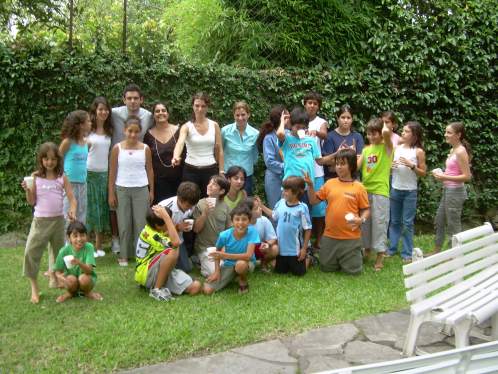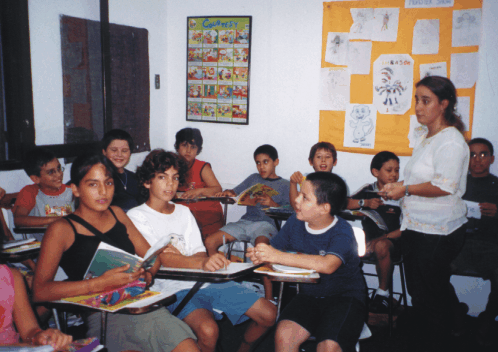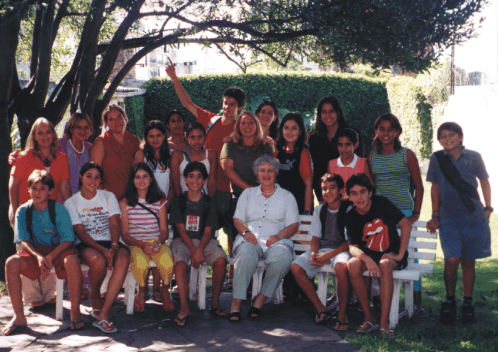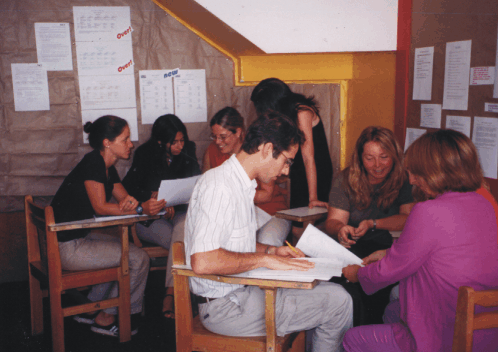

Setting New Year Resolutions... in November
Carla Boggio, Uruguay
Carla Boggio has been an English teacher from more than ten years and teacher trainer at Queen Victoria Institute, Montevideo, Uruguay (www.queenvictoriainstitute.com.uy) for the last five years. She was appointed University of Cambridge Celtyl Tutor in 2004, being a Celtyl graduate herself.
Menu
Introduction
Background
Examples
Conclusions
This time of the year is a special one for all of us teaching in the Southern hemisphere. The school year is about to be over, whether it means open lessons, end of term celebrations or rounding up before exams are due. It is the time when all the decisions taken beforehand, and the planning and the working will finally determine whether we have lived up to our expectations at the beginning of the year and where we have to keep on working. At the same time, it is when decisions for the year to come start being shaped.
Those decisions, taken by the institutions and the individuals, affect the outcome of our teaching practice. Some of them are like New Year resolutions - examples of good will that work well for a short term, but are forgotten shortly after we get absorbed in the everyday running of lessons. Some do change things remarkably, especially the ones that involve that work behind scenes, that work that is not easily noticed but with long term results and impact.
I remember that at this time, last year, I was myself setting goals for the year to come. There were, for me, four important areas where - both as a teacher / coordinator and teacher trainer - I wanted to work. Firstly, I wanted to make sure students felt the place theirs, felt they had a place, a say, that they were more to us than just one more student. Secondly, I wanted to experiment with some "new tools" I had read and heard about, to see them in practice, in my own environment. Thirdly, there was a need for students of all levels and ages to lose that "bookish" English they were very proficient at and acquire a more natural, real life language. And last but not least, I wished to get to the chance to share whatever came out of this experience with colleagues who could either learn about how this worked (or did not work) or give their own feedback on how to improve to get the outcome we are all looking for: getting students and teachers to enjoy and benefit from the teaching / learning experience.
Humanising the teaching / learning environment
Although the main aim of the institution (in this case a language school) was to make the students feel at ease and at home at the premises, we had the feeling that there was a gap which had not been bridged. There was still something else to be done, something that would really make the difference. The solution came to us from the students, and it was from the ones most of us would have expected the least. During summer watching sessions, one teenager noticed the lack of bright, colourful notice boards in classrooms. Then some other offered to help put them up once they were at the institute. Later a third one commented on how well (though how empty) the new student board at the main hall looked and when asked for suggestions the idea of flowers with the names of students written on the petals just followed naturally. And so we started our 'Welcome Garden', with flowers for the staff and a hopeful bunch of empty flowers for students.
As old students enrolled in their new courses, they came to find themselves a place on that notice board they had disregarded, a place for them to write their name or nickname. They were not Maria Perez or Juan Ramirez, they were Maria from CH2 and Juan from FCE. And each new student to the institute was surprised as well, for after completing the corresponding form and organising all the necessary details, they were taken to that wall where a place for their names was waiting for them, in the corresponding flower. Nothing simpler than this, yet none the less effective. The expression on students' faces when they looked at the growing flowers assured us that they now knew they belonged to the place - and that the place belonged to them.
Soon after lessons started, you could see photos or messages which had been put up, spontaneously. Even teachers contributed, with news from former members of staff or birthday greetings. The building of the sense of belonging was tangible now, for each of us to the point that not only did we all share things on this 'community' notice board, but also in classrooms. Students visiting other rooms, commenting on other students' work, getting engaged in conversation with other students apart from their classmates during break time - and knowing who was who… by their names.
Finding new ways
This good start provided the ground for more changes. After hearing and reading so much about NLP, Self-Esteem projects, the De Bono Thinking Hats and Lateral Thinking concepts, Brain Gym and the developments of the neurosciences, something had to be done. And thus started a campaign, aiming at getting as many colleagues as possible addicted to Teacher Development (reading articles, discussing them), fostering the spaces for experimenting this in the classroom. This is never an easy task, as anything new is always, at first, regarded as an extra burden to the already busy workload of teachers. 'With the planning and everything it brings about like considering the potential problems and alternative solutions, aiming at all the learning styles and catering for all the MI, plus taking into account learners' needs and preferences… now what else?!'
Probably 'what if' was what worked better than 'what else'. I stated by trying out different lesson paces, taking into account the chemical reactions mentioned by the neurosciences and allowing short 'brain breaks' during lesson time. Then I adapted my warm-ups so that they provided a chance to introduce some Brain Gym activities, instead of the traditional tasks. At first, students were reluctant, not seeing the point of such things, seeing them as a waste of time; but gradually they let themselves enjoy the fun of games for the sake of it to the point of challenging me now to find more ways of exercising their brains. Something similar happened with Lateral Thinking problems, which we used as the closure to each lesson. They are, at present, more engaged with finding new problems to solve - or new solutions to old problems - than with finding excuses for skipping lessons or not doing homework. Test results improved, as students developed strategies to overcome anxiety and to devise alternative (though plausible) solutions to any given problem (including not knowing the answer to a question). But the best advantage and most rewarding outcome is that this brought the fun of games, contagious laughter, the necessary element of surprise and motivation back to the classroom, in a natural way.
Bringing language to life
We are always trying to keep up to date with course books and materials to give language its 'natural look'. However, it is not surprising for us teachers to find ourselves using rather old-fashioned expressions and not knowing how real people communicate in everyday life (or at least, using little, if any, of that language in class). Our way of speaking becomes more standard, 'academic' type. And so, the 'mirroring' experience of our students: they cut and paste the model they have received, just changing the minimal information. They feel safe, and so do we, for how do we know for sure (without the feedback from a native speaker living in an English-speaking country) that the 'cool' words are still cool? Nobody runs risks, nobody finds out… nobody's language sounds real.
In order to break these taboos I tried this activity with some of my groups. Firstly, we set up a phrases and expressions bank, common to all the groups that shared the classroom, regardless of their level. Each lesson, either one of the students or me contributed with a phrase or expression found in any source (novel, song, film, web page) rather than the course book. Students then chose one and 'hired' it for a week, trying to find a way in which to use it, in a natural context. Students got really engaged and not only took interest in the phrases that came up within their own lessons, but also enquired about the rest of the words in the bank. As a result, their own lexis became less 'bookish' and more natural, having found that words came from the real world, not just the books and that new vocabulary was not just something the teacher decided to bring to class.
Last but not least - sharing
And so I came to my last goal - getting colleagues to share what they had done, encouraging goal setting and learning from everyone's feedback and experience. As I look back now, I see it happened gradually and naturally, by someone leaving notes and comments on the notice board in the staff room or exchanging thoughts and tasks along the corridors - or just by getting inspired to try new things by looking at their work, materials, plans. And one of the first conclusions that I came to from all this was that there was (almost) nothing new under the sun, that we were not being particularly innovative or extremely creative. It was the awareness of how simple, basic measures - which demanded little investment in terms of time, effort or money - had led to improve the whole atmosphere so greatly.
We rediscovered that fun is the key element because it certainly aids to memorizing and learning; that 'new' does not mean 'more work' but 'different'; that both learners and teachers can develop a sense of community, of belonging, of sharing spaces, responsibilities and knowledge, learning from one another. And in such a mood, feeling rewarded and inspired, we are now, as a group, setting new goals and objectives for the year to come, knowing that no matter how simple they might be, if they were set bearing in mind the human beings we are teaching and our will to achieve those goals, change is possible.





Please check the Creative Methodology for the Classroom course at Pilgrims website.
Please check the Building Positive Group Dynamics course at Pilgrims website.


|